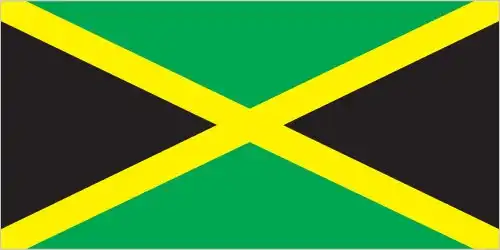Jamaica Flag
National Flag of Jamaica
Jamaica Flag Display

Quick Facts About Jamaica and flag of Jamaica
- Adopted:
- Aspect Ratio:
- 1:2
- Capital:
- Kingston
- Population:
- Approximately 2.9 million (2023)
Jamaica Flag - Description
The national flag of Jamaica features a gold saltire dividing the field into four triangles—black for the top and bottom, and green for the hoist and fly. Its bold geometry and vivid colors convey themes of strength, hope, and natural wealth.
Jamaica Flag – Symbolism and Meaning
Black acknowledges the trials and resilience of the Jamaican people; gold signifies sunshine, wealth, and natural beauty; green represents agricultural fertility and hope for the future. Collectively, the colors celebrate survival, optimism, and national pride.
Jamaica Flag - History and Origins
Introduced at independence from Britain on 6 August 1962, the flag was chosen from over 400 design submissions. The option featuring a diagonal saltire was selected to move away from colonial color schemes (red, white, blue). Its introduction signified a new era and a distinct national identity for Jamaica. The flag has since become a powerful representation worldwide of Jamaican culture and spirit.
Jamaica Flag - Design Elements
A 1:2 proportioned flag with a gold diagonal cross dividing four triangles—black at top and bottom, green at hoist and fly. The gold saltire meets exactly at the center, creating symmetrical geometry. The exact color shades are standardized for consistency across all uses, including state ceremonial flags and international representations.
Jamaica Flag - Usage Guidelines and Protocol
Jamaica’s flag is flown at government offices, schools, and during official ceremonies. On Independence Day (6 August) and national events like Emancipation Day, it is hoisted at sunrise and lowered at sunset. Flags must be clean and undamaged—worn or torn flags are to be replaced or respectfully destroyed. During national mourning, flags are flown at half-mast under government directive.
Frequently Asked Questions
What do the colors of the Jamaica Flag represent?
Black acknowledges the trials and resilience of the Jamaican people; gold signifies sunshine, wealth, and natural beauty; green represents agricultural fertility and hope for the future. Collectively, the colors celebrate survival, optimism, and national pride.
When was the Jamaica Flag adopted?
The Jamaica flag was adopted on 6 August 1962, marking an important milestone in the country's development as an independent nation.
What is the aspect ratio of the Jamaica Flag?
The Jamaica flag has an aspect ratio of 1:2, which determines the proportional relationship between its width and height for official display purposes.